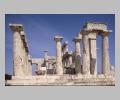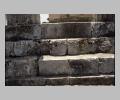
Model of sanctuary, showing temple, from N
| Context: | Aegina, Sanctuary of Aphaia |
| Type: | Temple |
| Summary: | Peripteral temple; in the Sanctuary of Aphaia. |
| Date: | ca. 500 BC - ca. 480 BC |
| Dimensions: | Width of the stylobate 28.8 x 13.8 m (42.5 Doric feet); axial spacing of columns: 2.6 m. (slightly less on the sides). |
| Region: | Saronic Gulf |
| Period: | Archaic |
Plan:
Doric peripteral temple, 6 x 12 columns. A 3 stepped sloping ramp provided access at the east end. The temple had a pronaos and an opisthodomos, both distyle in antis and a cella with 2-story colonnade and gallery. A ladder led to the upper gallery, which was perhaps used to store votives. All but 3 column shafts were monolithic; the three drum-built columns were perhaps left open during construction to allow access to the interior of the temple.
History:
An early temple of ca. 570 BC was probably built on the site; fragments of this structure were built into the terrace wall. The temple was decorated with sculptures in the two pediments. An early set (East Pediment 1 and West Pediment 1), carved in the early fifth century, was discarded for uncertain reasons (possibly political) and set up in the sanctuary flanking the altar. The later set (East Pediment 2 and West Pediment 2) was carved shortly afterwards, the east pediment slightly later than the west. See the discussions in the sculpture catalog. The opisthodomos was originally separated from the cella by a solid wall; later a door was cut through the wall, connecting the two rooms.
Other Bibliography:
See Also:




